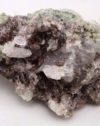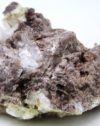HISTORY, NAME, LOCALITIES: Charoite was discovered in the 1940s near the Chary River in the Eastern-Siberia Region of the Russia (then the Soviet Union). It was recognized as a mineral species in 1978 and named for its type locality near the Chary River. Charolite occurs in only a few localities in the Murunskii Massif area of the Aldan Shield in northeastern Russia.
MINERALOGY, PROPERTIES, OCCURRENCE: Charoite [basic hydrous potassium sodium calcium fluorosilicate, K(Ca,Na)2Si4O10(OH,F)•H2O] crystallizes in the monoclinic system in massive or fine-grained, fibrous forms. Crystals are rare. It has a Mohs hardness of 5.0-6.0, a specific gravity of 2.6, poor cleavage in three directions, and a vitreous-to-pearly luster. Charolite’s color is a diagnostic, distinctive, bright purple or lilac; impurities may shift the color to a purplish-brown. Charolite is known to occur only in metasomatic rocks in syenite massifs.
METAPHYSICAL PROPERTIES, LORE, USES: According to metaphysical practitioners, charoite is a stone of transformation and power that enhances creativity, spiritual growth, courage, and inner strength, while aiding both emotional and physical healing. Charoite is a popular gemstone and decorative stone. It is cut and polished into cabochons and tumbled into beads for use in various types of jewelry. As a decorative stone, it is carved into such objects as bookends, paperweights, and figurines. The color of charoite is unique among all gemstones and decorative stones.
COLLECTORS’ INFORMATION: Charoite is collected for its rarity and unique purple colors.





 Axinite #10
Axinite #10  Axinite #8
Axinite #8